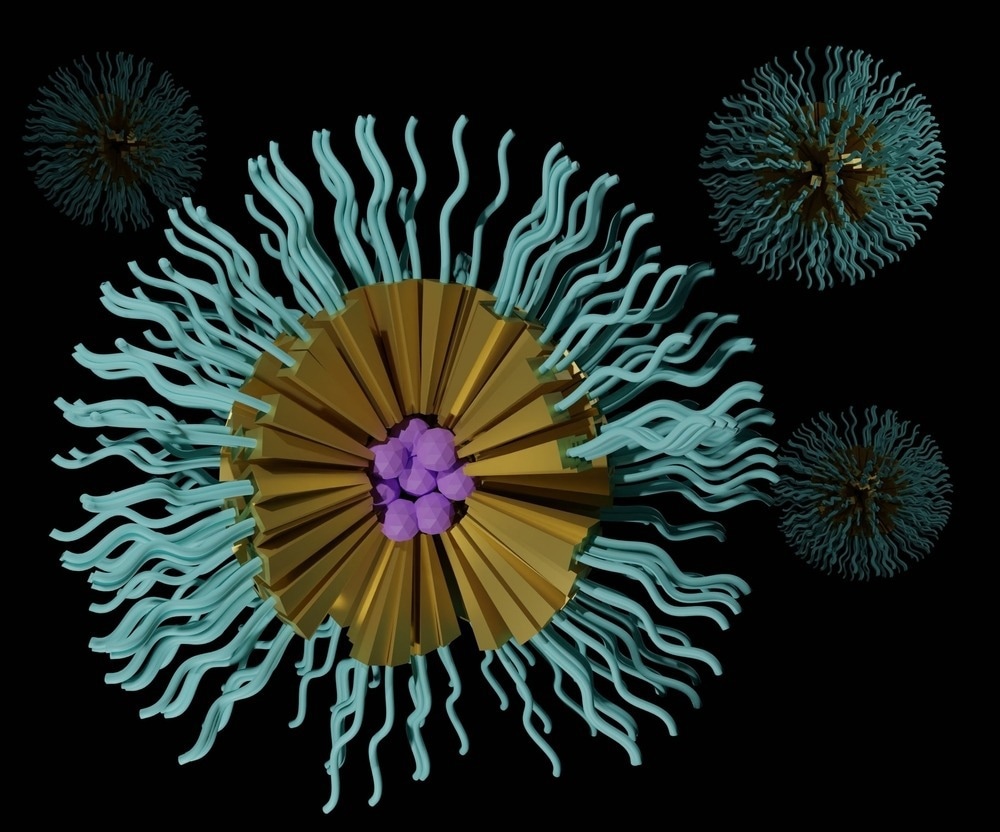In a paper recently published in the open-access journal ACS Polymers Au, researchers used a coarse-grained model to investigate the effect of network-like architectures over mechanochemical activation among self-assembled triblock copolymers.

Study: Computational Study of Mechanochemical Activation in Nanostructured Triblock Copolymers. Image Credit: Love Employee/Shutterstock.com
Background
The capacity to induce chemical processes by exerting forces across chemical bonds has gathered the interest of researchers as a platform for self-healing materials, chemical catalysis, and strain sensing. The polymer network topology and molecular weight, on the other hand, have a strong influence on whether chains encounter adequate forces to initiate the force-responsive bonds prior to material relaxation and even distribution of the forces across all chains, which also impacts the overall activation efficiency.
Block copolymers (BCPs) are an appealing choice for managing both the bulk force transmissions and the network-like topology on a molecular scale, as well as the material's overall mechanical characteristics.
Although the effect of chain conformations on the mechanical behavior of cross-linked networks and triblock has previously been examined, the impact of those conformations on the effectiveness of the mechanochemical activation within the material is unclear. However, considerable work needs to be done to determine the significance of certain network topological properties in promoting or inhibiting mechanochemical activation in these materials. Understanding the effect of morphology on mechanochemical activation requires clarifying the spatial positions and specific conformations of the activated molecules.
About the Study
In this study, coarse-grained simulations of ABA triblock copolymers were carried out with a bead-spring model for the parametrization of average amorphous densities, glass transition temperatures, and Kuhn segment molecular weights to match poly(methyl methacrylate)-block-poly(n-butyl acrylate)-block-poly(methyl methacrylate)-block-poly(methyl methacrylate) (PMMA-b-PbBA-b-PMMA) triblock copolymers.
The PMMA-b-PnBA-b-PMMA system was selected because it creates suitably ordered morphologies and can be generated through moderated radical polymerizations well-suited with the spiropyran mechanophore. Three polymer composition samples were prepared, and 10 separate copies of each composition were equilibrated. The systems self-assembled into the predicted morphologies from the self-consistent field theory's phase diagrams (SCFT).
The stress-strain behavior of cylindrical, lamellar, and spherical samples was measured as a function of morphology by deforming them normal to their periodic microstructures at fixed volume. The mechanophore linkage lengths in the center of each chain were analyzed to calculate each sample's mechanochemical activation induced by strain across each deformation run. Activation, like stress, was studied as a function of chain type. Each system underwent further uniaxial deformation testing with force exerted in the direction of the other axes.
Observations
The equilibration method produced effectively equilibrated triblock copolymer samples with network-like structures. Altogether, the stress-strain curves exhibited a predicted pattern, with stress increasing as the proportion of the sample's glassy component increased. The lamellar morphology had the highest absolute stress, followed by the cylindrical morphology, while the spherical morphology had the lowest stress. Under the same overall stress, the cylindrical and spherical morphologies showed activation energy higher than that of the lamellar morphology.
Using simulations based on molecular dynamics for modeling the activation allowed the responses of the loop, hooked, and tie chains to be evaluated independently, which is unattainable in experimental systems. Hooked and tie chains activated far more effectively than loop chains, confirming that activation was substantially influenced by chain conformations, highlighting the importance of network-like topology in influencing the force transmission to (and activation of) each polymer chain. The findings showed that block copolymer systems warrant additional research as mechanochemical activation platforms.
Furthermore, a spherical morphology can give the optimum balance of activation efficiency and low modulus for an activation-based application at high strain and low stress, whereas a lamellar morphology will be further ideal for activations at low strain and high stress. Reducing the rate of strain led the mechanophores to activate sooner due to the relaxation of the chains and even force transmission to the mechanically active link. Moreover, activation was observed towards the points of the buckled chevron pattern in the lamellar samples. This result suggested that grain boundaries may show more evident activation, where distinct lamellar morphological orientations join.
Conclusions
To summarize, the researchers created a basic model mechanophore that could be included in coarse-grained polymeric bead-spring models and utilized it to evaluate mechanochemical activation in well-ordered triblock copolymers. It was determined that the greater glassy end block percentages in triblock copolymers required additional stress for the activation of the mechanophore unit in the midblock than in triblocks consisting of lower glassy block proportions.
It was also established that hooked loop chains had similar behavior to that of tie chains, with identical stress-activation curves. Additionally, the team confirmed spatial non-uniformity of activation and that it relied on the location of the mechanophore within the self-assembled morphology. Furthermore, the activation is also dependent on the distortion of morphology due to tensile deformation. According to the authors, this study implies that this field could be a promising path for future experimental investigation.
More from AZoM: What are Biopolymer-Based Hydrogel Electrolytes?
Disclaimer: The views expressed here are those of the author expressed in their private capacity and do not necessarily represent the views of AZoM.com Limited T/A AZoNetwork the owner and operator of this website. This disclaimer forms part of the Terms and conditions of use of this website.
Source:
Huo, Z., Skala, S., Falck, L., Laaser, J., Statt, A., Computational Study of Mechanochemical Activation in Nanostructured Triblock Copolymers, ACS Polymers Au. DOI: https://pubs.acs.org/doi/10.1021/acspolymersau.2c00031